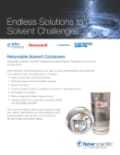Solvents Resource Center
Common Uses of Solvents
Solvents are liquid, gas, or solid chemicals that dissolve, extract, or suspend other substances. The most common and universal solvent is water, which dissolves more substances than any other.
More about solvents
Top Solvents
Learn about each solvent’s physical and chemical properties, uses, designations and grades, and more.
Additional Solvents Resources
Download the following resources to learn more about solvent selection and browse our portfolio.
Returnable Solvent Containers Data Sheet
See how reusable solvent containers can help solve contamination problems and streamline your operations.
Solvents Application Guide
Learn more about Thermo Scientific and Fisher Chemical products, packaging, and delivery systems.
- Solvents Application Guide (8.8 MB)
Fisher Chemical Solvents Data Sheet
Browse solvents suited for HPLC, gas chromatography, and more while reducing your chemical footprint.
- Fisher Chemical Solvents Data Sheet (490.1 KB)
Honeywell Solvents Whitepaper
Review how Honeywell solvents perform compared to other leading brands.
More
Honeywell ACS Solvents Data Sheet
Discover reagent-grade solvents for general laboratory use, a value priced solution that meets your needs.
- Honeywell ACS Solvents Data Sheet (547.8 KB)
Chromatography Workflow Brochure
Find solvents for each step of your sample preparation and HPLC workflows.
- Chromatography Workflow Brochure (880.1 KB)






